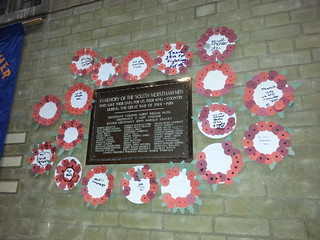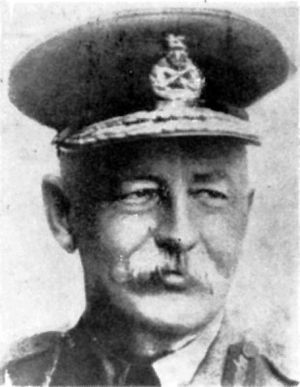We took our cubs to the local war memorial in the Church just down the road from the Scout Hall. Before we went we”d got the cubs to make a wreath of poppies and to write a message on it. Each boy did his own personal wreath. We then went on a walk down the road and went into the Church where we spoke to them about why we remember and also how things were different back in 1914. South Merstham wasn”t as big then as it is now, for a start the new houses were mostly built in the 1950s. In the 1911 census there were somewhere in the region of 600 men in the locality, about 150 of whom signed up in August 1914 (I”m guessing some would be unfit, others in jobs that couldn”t just go off to war and some others not that keen).
Remembrance Challenge
At the end of the session we gave each of the cubs a slip of paper with one of the names from the WW1 memorial in the church and the Commonwealth War Graves Commission website. They were asked to come up with what they could about the name they were given. I took a name too, and being more grown up and a bit of an analyst I went a bit further than just the CWGC website. I didn”t pay for any information though, I only used free open sources.Why don”t you go down to your war memorial and do something similar. Post your findings on your favourite social media and challenge your friends.
Who was William English?
William English was born in Bletchingley in the Autumn of 1874, his father was Gordon English (who lived in South Merstham by 1918). In the summer of 1905 he married Catherine Colgate Dagnall in Reigate. Catherine was born in Reigate in the Summer of 1879 and her family is reasonably well documented on http://loiselden.com/tag/dagnall/.The search entry for the 1911 census (which I couldn”t see the whole record of without paying) showed that William was a caretaker in 1911. He seems to be in Reigate, although I couldn”t quite see the address details. His wife is listed as living at 14 Croydon Road in Reigate by CWGC, he may well have been living there at the time, or she could have moved after his enlistment.
War Service
William”s service number is G/450 and he is listed as an Acting Company Sergeant Major with the 7th (Service) Battalion of the Queen”s (Royal West Surrey) Regiment at the time of his death in May 1918.His regimental service number is very low, the series was used for the wartime volunteers and started in August 1914. This suggests that he was in the first batch of volunteers, although the battalion he served with is part of K2, or the second hundred thousand volunteers. Either way it is likely he was with the 7th (Service) Battalion (NB there was another 7th Bn of the Queen”s Regiment).
7th (Service) Battalion, Queen’s Regiment
Sept 1914 Formed at Guildford as part of the Second New Army (K2) and then moved to Purfleet to join the 55th Brigade of the 18th Division then moved to Colchester.
May 1915 Moved to Salisbury Plain.
27.07.1915 Mobilised for war and landed at Boulogne. This is the start of the Battalion war diary which has been digitised and you can read it online. The first entry lists all the officers and warrant officers with the battalion as well as the overall strength. William English was not a CSM at this stage.
The Battalion spent most of 1916 in the line or resting between spells at the front. It was one of the assault battalions on 1st July and while it took casualties these weren’t enough to stop it actively participating in The Battle of Albert, The Battle of Bazentin Ridge, The Battle of Delville Wood, The Battle of Thiepval Ridge, The Battle of the Ancre Heights, The Battle of the Ancre.
1917 was a similar pattern of operations with periods of rest, consolidation & training between spells in the front line trenches. Operations on the Ancre, The German retreat to the Hindenburg Line, The Third Battle of the Scarpe, The Battle of Pilkem Ridge, The Battle of Langemarck, First Battle of Passchendaele, The Second Battle of Passchendaele. Notably it took a pasting at Passchendaele and lost a lot of men.
In 1918 the battalion was in the line when the Michael offensive happened, and two companies were completely lost, in addition to casualties taken in the other companies that managed to retire. I’d surmise that this is when William English, as an Acting CSM, was captured by the Germans. I’d also guess that he was wounded when he was captured and this is what lead to his death in Germany on 9th May 1918.
It is possible that he was captured earlier and that there was some other cause of death, without seeing a death certificate or a service record (I looked and could not find his service record at all) it is difficult to be sure. I read the entire battalion war diary from when it starts in 1915 up to May 1918 and he isn’t mentioned once. The CSMs occasionally get a mention, usually when they are either replacing the RSM, leaving to be commissioned or running some instruction for junior officers.
Knowing that the role usually keeps them moving between the rear and the front when in action, and ensuring discipline and training in camp it is unlikely that a CSM would be taken prisoner except when the lines are fluid, which is during a large battle. CSMs don’t usually go out and patrol, they’re more likely to be checking sentries or that the rations and ammo have come up if they are in the trenches. In battle they may well be moving forwards to find where people are, which would make them more prone to capture. In a retirement they may not have been with the company when orders were given to retire and could easily turn up where the enemy now are.
CSM William English is listed as a Prisoner of War in the Queen’s Regiment archives, and he is buried in the Niederzwehren cemetery, Kasseler Stadtkreis, Hessen, Germany. This is a concentration cemetery bringing in graves from POWs from southern Germany.
That’s what I know. If you know more please drop me a comment.
Thanks.
Some Sources
Commonwealth War Graves Commission http://www.cwgc.org/
basic info about casualties, as a minimum name, rank, regiment & date of death
UK, Soldiers Died in the Great War, 1914-1919
normally paid but usually free around 11 November each year, has slightly more information that CWGC tends to have
Records of the Queen’s Regiment are online, some with Surrey County Council
FreeBMD (& FreeCEN)http://www.freebmd.org/
Has copies of the transcribed indexes of Births, Marriages & Deaths in England and Wales from the General Register Office. These aren’t very detailed, they’re just intended to point you at the correct page in the register. If you have time you can go into a register office and see the register for free, although they will encourage you to order a certificate instead.
Birth Index Oct-Dec 1874
Surname Given Name District Volume Page
ENGLISH William Godstone 2a 172
Jul-Sep 1879
Dagnall Catherine Colgate Reigate 2a 168
Marriage Jul-Sep 1905
Surname Given Name District Volume Page
ENGLISH William Reigate 2a 439
DAGNALL Catherine Colgate Reigate 2a 439








